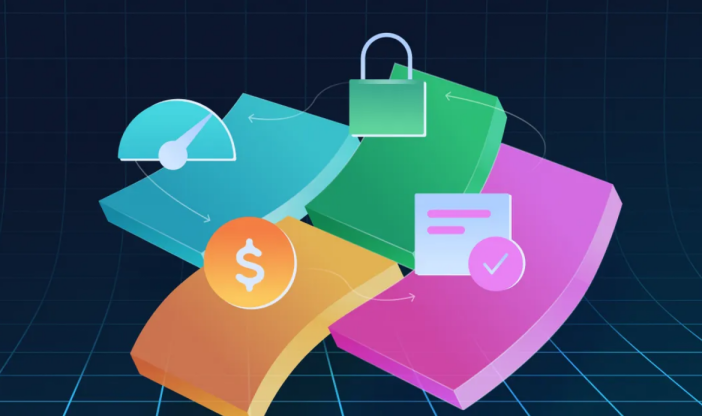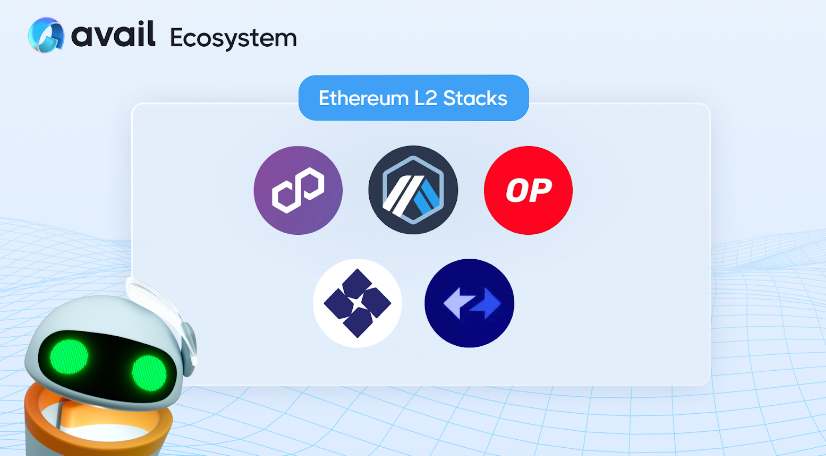
As modular blockchain architecture becomes mainstream, many teams are building different parts of the blockchain stack. Avail’s underlying data availability layer plays a key role in all of this, as it is designed to support upper-layer applications of multiple blockchains. By leveraging a similar mindset to Web2’s microservices architecture, developers can enable verifiable blockchain computing to cover every corner of the Internet. Software engineers are building a new generation of blockchains using this cutting-edge technology stack. With the launch of Avail DA on the mainnet, or soon after, builders across the ecosystem will deploy this technology.
Ethereum L2 Stack
A handful of Ethereum Rollup stacks have been well-battle-tested, and the five most popular Ethereum Rollup stacks are now integrated with Avail DA. These stacks include Arbitrum, Optimism, Polygon CDK, Starknet, and zkSync. This enables developers to use these popular Rollup stacks and easily leverage Avail DA’s unique feature set. Developers can use this combination to build general-purpose or application-specific blockchains.
Arbitrum Orbit: Arbitrum Orbit is a Rollup stack tested by hundreds of applications and millions of users on Arbitrum One. The Arbitrum Orbit chain provides developers with tools to build their own blockchain applications using the Arbitrum Nitro stack.
OP Stack: The OP Stack is a standardized, shared, and open source development stack maintained by the Optimism Collective that supports the operation of Optimism.
Polygon CDK: Polygon CDK enables you to build a ZK-powered Layer 2 that fits your needs. Its modular, open source software toolkit allows blockchain developers to launch new zero-knowledge proof L2 chains.
StarkWare: StarkWare focuses on building application chains using the Madara Rollup framework to increase transaction speed while reducing costs.
zkSync Hyperchains: zkSync Hyperchains is powered by the same engine as the zkEVM engine on the ZK Stack and is currently powering the first hyperchain, zkSync Era, which can be developed by anyone and deployed without permission.
Application-Specific Chains
One of the modern wonders of the Internet is the idea of application-specific microservices. Netflix, Uber, and nearly everything you interact with today are built by combining many smaller, loosely coupled microservices that communicate with each other and create applications that can scale to millions (and in some cases billions) of users.
Blockchain technology wasn’t previously well suited to this approach, but it is now ready. Just like modern application development, teams are creating blockchains that serve specific purposes. These blockchain-based building blocks enable developers to create more complex applications for their users. Avail DA is the platform that supports this application-specific activity.
Avail DA’s Unique Advantages
At its core, Avail DA is its modular design, which allows it to integrate seamlessly with a wide variety of blockchain architectures. Here are some application-specific blockchains that leverage Avail DA, which adopts a new modular Web3 primitive to expand the way the Internet operates:
Arbitrum Orbit: Provides developers with tools to use the Arbitrum Nitro stack.
OP Stack: A standardized, shared, and open source development stack.
Polygon CDK: Allows developers to launch new zero-knowledge proof L2 chains.
StarkWare: Increase transaction speed and reduce costs through the Madara Rollup framework.
zkSync Hyperchains: Powered by the zkEVM engine, it can be deployed without permission.
Future development of Avail DA
With the launch of Avail DA on the mainnet, more teams and developers are expected to adopt this technology. The advantage of modular blockchain architecture lies in its flexibility and scalability, which enables developers to build and customize blockchain applications according to specific needs. This not only improves development efficiency but also reduces development costs.

Conclusion: The combination of modular blockchain architecture and Avail DA brings new possibilities for the development of blockchain technology. By leveraging a mindset similar to the Web2 microservice architecture, developers can create more complex and efficient blockchain applications. As more teams and developers adopt this technology, the future of blockchain will be brighter and more diverse.